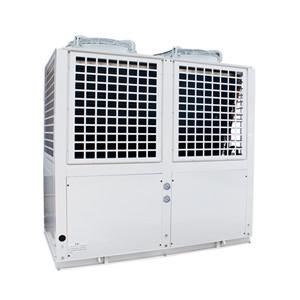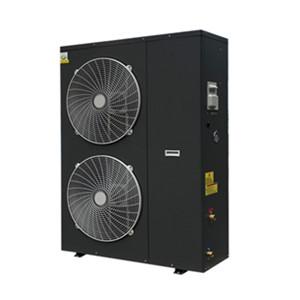Description
Cold climate heat pumps are energy efficient and can reduce
your carbon footprint if they are replacing fossil fuel source heating systems.
They transfer heat from the outdoor air to your home.
Cold climate air source heat pumps are slightly more efficient and can
operate in cooler temperatures than traditional air source heat pumps.
Conventional heat pumps typically lose significant heating capacity at cooler
temperatures. Running them when the temperature drops below -10°C is generally
not recommended, while cold climate heat pumps can still provide -25°C or -30°C
heat, depending on the manufacturer's specifications.
There are two main types of cold climate air source heat pumps.
1. Central pipeline
A central ducted heat pump looks like a central air conditioner. It has
an outdoor unit and a coil located inside the home duct.
In summer, the heat pump operates like a central air conditioner.
Circulation fans move air over indoor coils. The refrigerant in the coil
absorbs heat from the indoor air and pumps the refrigerant to the outdoor coil
(condenser unit). Outdoor units vent any heat in the home to the outside air
while cooling the home.
During winter, the heat pump reverses the flow of refrigerant and the
outdoor unit absorbs heat from the outdoor air and transfers it to the indoor
coils in the ductwork. The air passing through the coils absorbs heat and
distributes it inside the house.
2. Mini split type (pipeless)
A small split heat pump operates similarly to a central ducted heat
pump, but it does not use ductwork. Most small split or ductless systems have
an outdoor unit and 1 or more indoor units (headers). The indoor unit has a
built-in fan that moves air over the coil to absorb or release heat from the
coil.
Systems with multiple indoor units are often required to heat and cool
the entire home. Small split heat pump systems are best for homes without
ductwork, such as those with hot water boilers, steam boilers, or electric
baseboard heaters. Mini-split systems are also ideal for homes with
open-concept floor plans that require fewer indoor units.
Maintain
1. Check the air filter every 3 months to see if it needs to be
replaced;
2. Routine inspection to ensure that the air supply and return air vents
are unobstructed;
3. Daily inspection and cleaning of outdoor coils to ensure that they
are free of leaves, seeds, dust and lint;
4. Annual system inspection by a qualified service professional.
5. A licensed refrigeration mechanic can advise you of additional
operating and maintenance details about your system.
Operating temperature
Air source heat pumps have the lowest outdoor operating temperatures,
and their heat production decreases significantly as the outdoor air
temperature drops. Air source heat pumps typically require an auxiliary heat
source to maintain indoor heating temperatures in the coldest weather.
Auxiliary heat sources for cold climate units are usually electrical coils, but
some units can be used with gas furnaces or boilers.
Most air source systems shut down at 1 of 3 temperatures, which can be set by your contractor during installation:
1. Thermal equilibrium point
At this temperature, the heat pump does not have enough capacity to heat
the house on its own.
2. Economic equilibrium
The temperature at which one fuel becomes more economical than another.
In cooler temperatures, it may be more cost-effective to use supplemental
fuels, such as natural gas, than to use electricity.
3. Low temperature cut off
Heat pumps can operate safely to this minimum operating temperature, or
with an efficiency equal to or lower than an electric auxiliary heating system.
4. Controls
We recommend having a thermostat controller that runs both the air
source heat pump and the auxiliary heating system. Installing 1 controller will
help prevent the heat pump and backup heating system from competing with each
other. Using separate controls also allows the auxiliary heating system to
operate while the heat pump is cooling.
Advantage
1. Energy saving
Cold climate air source heat pumps are more efficient than other systems
such as electric furnaces, boilers and baseboard heaters.
2. Environmentally friendly
Air source heat pumps transfer heat from outside air and add it to the
heat produced by an electric compressor to heat your home. This can reduce your
home's energy use, greenhouse gas emissions and harmful effects on the
environment.
3. Versatility
Air source heat pumps heat or cool as needed. Homes with cold climate
air source heat pumps do not need a separate air conditioning system.
Is it suitable for my home?
Keep these factors in mind when considering an air source cold climate
heat pump for your home.
1. Costs and Savings
Cold climate air source heat pumps can reduce your annual heating costs
by 33% compared to electric heating systems. If switching from propane or oil
fired furnaces or boilers (depending on the seasonal efficiency of these
systems), savings of 44% to 70% can be achieved. However, the cost will usually
be higher than a natural gas heating system.
The cost of installing an air source heat pump depends on the type of
system, existing heating equipment, and the ductwork in your home. Some
modifications to plumbing or electrical services may be required to support
your new heat pump installation. Air source heat pump systems cost more to
install than traditional heating and air conditioning systems, but your annual
heating costs will be lower than electricity, propane, or oil heating. Home
energy efficiency loan financing is available to help cover installation costs.
2. Local climate
When shopping for a heat pump, the Heating Seasonal Performance Factor
(HSPF) should help you compare the efficiency of 1 unit in mild winter weather.
The higher the HSPF number, the higher the efficiency. Note: Manufacturers'
HSPF is generally limited to specific areas with much milder winter
temperatures and is not indicative of how it will perform in colder climates.
Most cold climate air source heat pumps are no more efficient than
electric heating when temperatures drop below -25°C.
3. Installation Requirements
The location of the outdoor unit depends on airflow, aesthetic and noise
considerations, and snow blockage. If the outdoor unit is not mounted on a wall
mount, it should be placed in an open area on the platform to allow defrost and
meltwater to drain and minimize snow cover. Avoid placing the device near
sidewalks or other areas, as melted water may create a slip or fall hazard.
Follow the manufacturer's installation recommendations.
Hire a contractor
Your equipment must be installed by a professionally licensed
refrigeration mechanic. Your installer should perform heat loss calculations to
ensure the system is sized for your home.






